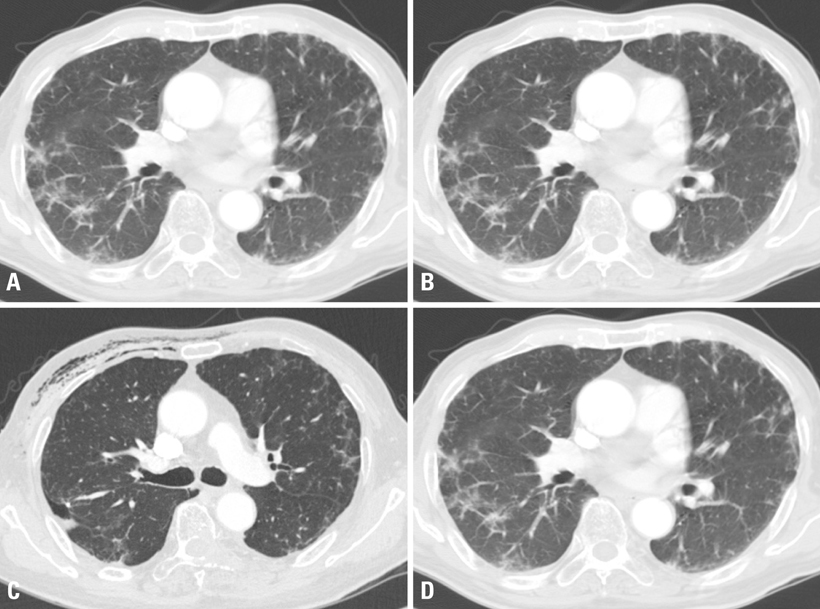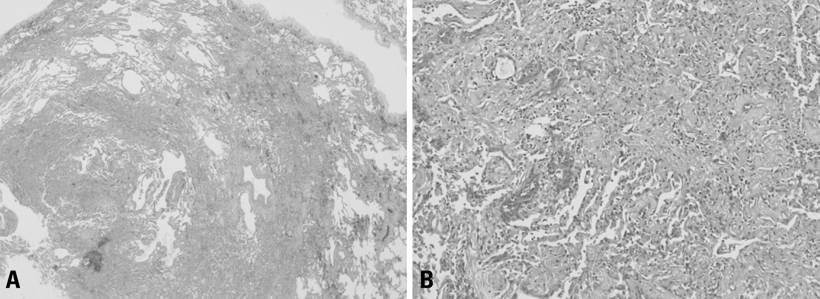Yonsei Med J.
2010 May;51(3):448-450. 10.3349/ymj.2010.51.3.448.
Nonspecific Interstitial Pneumonitis after Bortezomib and Thalidomide Treatment in a Multiple Myeloma Patient
- Affiliations
-
- 1Department of Internal Medicine, Yonsei University College of Medicine, Seoul, Korea. pms70@yuhs.ac
- 2Department of Pathology, Bundang CHA Hospital, CHA University College of Medicine, Seongnam, Korea.
- KMID: 1074999
- DOI: http://doi.org/10.3349/ymj.2010.51.3.448
Abstract
- Bortezomib, an inhibitor of 26S proteosome, is recently approved treatment option for multiple myeloma. Thalidomide, a drug with immunomodulating and antiangiogenic effects, has also shown promise as an effective treatment in multiple myeloma. Pulmonary complications are believed to be rare, especially interstitial lung disease. Here, we describe a patient with dyspnea and diffuse pulmonary infiltrates while receiving bortezomib and thalidomide in combination with dexamethasone for treatment-naive multiple myeloma. Bronchoalveolar lavage demonstrated a significant decrease in the ratio of CD4 : CD8 T lymphocytes (CD4/8 ratio, 0.54). Extensive workup for other causes, including infections, was negative. A lung biopsy under video-assisted thorascopic surgery revealed a diagnosis of nonspecific interstitial pneumonitis. The symptoms and imaging study findings improved after initiating steroid treatment. Physicians should be aware of this potential complication in patients receiving the novel molecular-targeted antineoplastic agents, bortezomib and thalidomide, who present with dyspnea and new pulmonary infiltrates and fail to improve despite treatment with broad-spectrum antibiotics.
MeSH Terms
Figure
Reference
-
1. Ghobrial IM, Leleu X, Hatjiharissi E, Hideshima T, Mitsiades C, Schlossman R, et al. Emerging drugs in multiple myeloma. Expert Opin Emerg Drugs. 2007. 12:155–163.
Article2. Richardson PG, Hideshima T, Mitsiades C, Anderson KC. The emerging role of novel therapies for the treatment of relapsed myeloma. J Natl Compr Canc Netw. 2007. 5:149–162.
Article3. Colson K, Doss DS, Swift R, Tariman J, Thomas TE. Bortezomib, a newly approved proteasome inhibitor for the treatment of multiple myeloma: nursing implications. Clin J Oncol Nurs. 2004. 8:473–480.
Article4. Dimopoulou I, Bamias A, Lyberopoulos P, Dimopoulos MA. Pulmonary toxicity from novel antineoplastic agents. Ann Oncol. 2006. 17:372–379.5. Onozawa M, Hashino S, Sogabe S, Haneda M, Horimoto H, Izumiyama K, et al. Side effects and good effects from new chemotherapeutic agents. Case 2. Thalidomide-induced interstitial pneumonitis. J Clin Oncol. 2005. 23:2425–2426.6. Jagannath S, Barlogie B, Berenson JR, Singhal S, Alexanian R, Srkalovic G, et al. Bortezomib in recurrent and/or refractory multiple myeloma. Initial clinical experience in patients with impaired renal function. Cancer. 2005. 103:1195–1200.
Article7. Miyakoshi S, Kami M, Yuji K, Matsumura T, Takatoku M, Sasaki M, et al. Severe pulmonary complications in Japanese patients after bortezomib treatment for refractory multiple myeloma. Blood. 2006. 107:3492–3494.
Article
- Full Text Links
- Actions
-
Cited
- CITED
-
- Close
- Share
- Similar articles
-
- Diagnosis and therapy of multiple myeloma
- A Case of Acute Pancreatitis Caused by Bortezomib in a Patient with Multiple Myeloma
- Reversible Heart Failure after Bortezomib Treatment in a Patient with Multiple Myeloma
- A Case of Cutaneous Plasmacytoma Treated with Thalidomide
- Thalidomide Induced Nonspecific Interstitial Pneumonia in Patient with Relapsed Multiple Myeloma



